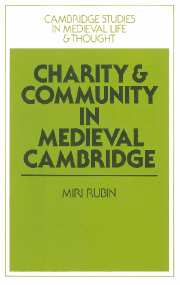Book contents
- Frontmatter
- Contents
- List of tables
- Acknowledgements
- List of abbreviations
- Map
- 1 INTRODUCTION
- 2 THE ECONOMIC BACKGROUND: SUPPLY AND DEMAND FOR CHARITY
- 3 THE IDEA OF CHARITY BETWEEN THE TWELFTH AND FIFTEENTH CENTURIES
- 4 THE CHARITABLE HOUSES OF MEDIEVAL CAMBRIDGE AND ITS SURROUNDINGS
- 5 LIFE IN A MEDIEVAL HOSPITAL: THE HOSPITAL OF ST JOHN, CAMBRIDGE
- 6 THE RELIGIOUS AND ECONOMIC FUNCTIONS OF THE HOSPITAL OF ST JOHN
- 7 CORPORATE AND INDIVIDUAL ACTS OF CHARITY
- 8 EPILOGUE
- Appendix 1 The rule of the hospital of St John the Evangelist, Cambridge
- Appendix 2 The list of masters of the hospital of St John the Evangelist, Cambridge (c. 1207–1507)
- Bibliography
- Index
4 - THE CHARITABLE HOUSES OF MEDIEVAL CAMBRIDGE AND ITS SURROUNDINGS
Published online by Cambridge University Press: 28 October 2009
- Frontmatter
- Contents
- List of tables
- Acknowledgements
- List of abbreviations
- Map
- 1 INTRODUCTION
- 2 THE ECONOMIC BACKGROUND: SUPPLY AND DEMAND FOR CHARITY
- 3 THE IDEA OF CHARITY BETWEEN THE TWELFTH AND FIFTEENTH CENTURIES
- 4 THE CHARITABLE HOUSES OF MEDIEVAL CAMBRIDGE AND ITS SURROUNDINGS
- 5 LIFE IN A MEDIEVAL HOSPITAL: THE HOSPITAL OF ST JOHN, CAMBRIDGE
- 6 THE RELIGIOUS AND ECONOMIC FUNCTIONS OF THE HOSPITAL OF ST JOHN
- 7 CORPORATE AND INDIVIDUAL ACTS OF CHARITY
- 8 EPILOGUE
- Appendix 1 The rule of the hospital of St John the Evangelist, Cambridge
- Appendix 2 The list of masters of the hospital of St John the Evangelist, Cambridge (c. 1207–1507)
- Bibliography
- Index
Summary
The charitable institutions of Cambridgeshire comprised the urban hospitals and leper houses of Cambridge, Ely and Wisbech, and the rural charitable houses at Stow (now Longstow), Fordham, Anglesey, in the fields of Royston and in Newton. The largest and best documented is the Hospital of St John the Evangelist in Cambridge, but a survey of other hospitals in the county, which is largely identifiable with the diocese of Ely, sets this charitable institution in sharper focus. It also allows us to examine the degree of integration between urban and rural provision for the poor, and the degree of episcopal involvement in charitable activities within the diocese.
IN THE TOWN OF CAMBRIDGE
The Hospital of St John the Evangelist (HSJC)
Hospitals were founded in widely differing circumstances, but for most hospitals very little knowledge about their earliest years remains. Some time after its foundation, with the accession of an active bishop, with the grant of a sizeable donation or with the provision of a rule, a hospital emerged from the shadows. Our knowledge of the circumstances of the foundation of HSJC depends on the insecure evidence of an inquisition held some 70 years later. It is of great interest to speculate whether the hospital was founded by the community of Cambridge burgesses, by the bishop of Ely or by a pious individual townsman, even though we will not be able to say for certain where the truth lies.
- Type
- Chapter
- Information
- Charity and Community in Medieval Cambridge , pp. 99 - 147Publisher: Cambridge University PressPrint publication year: 1987



